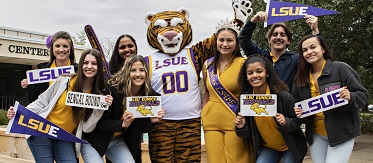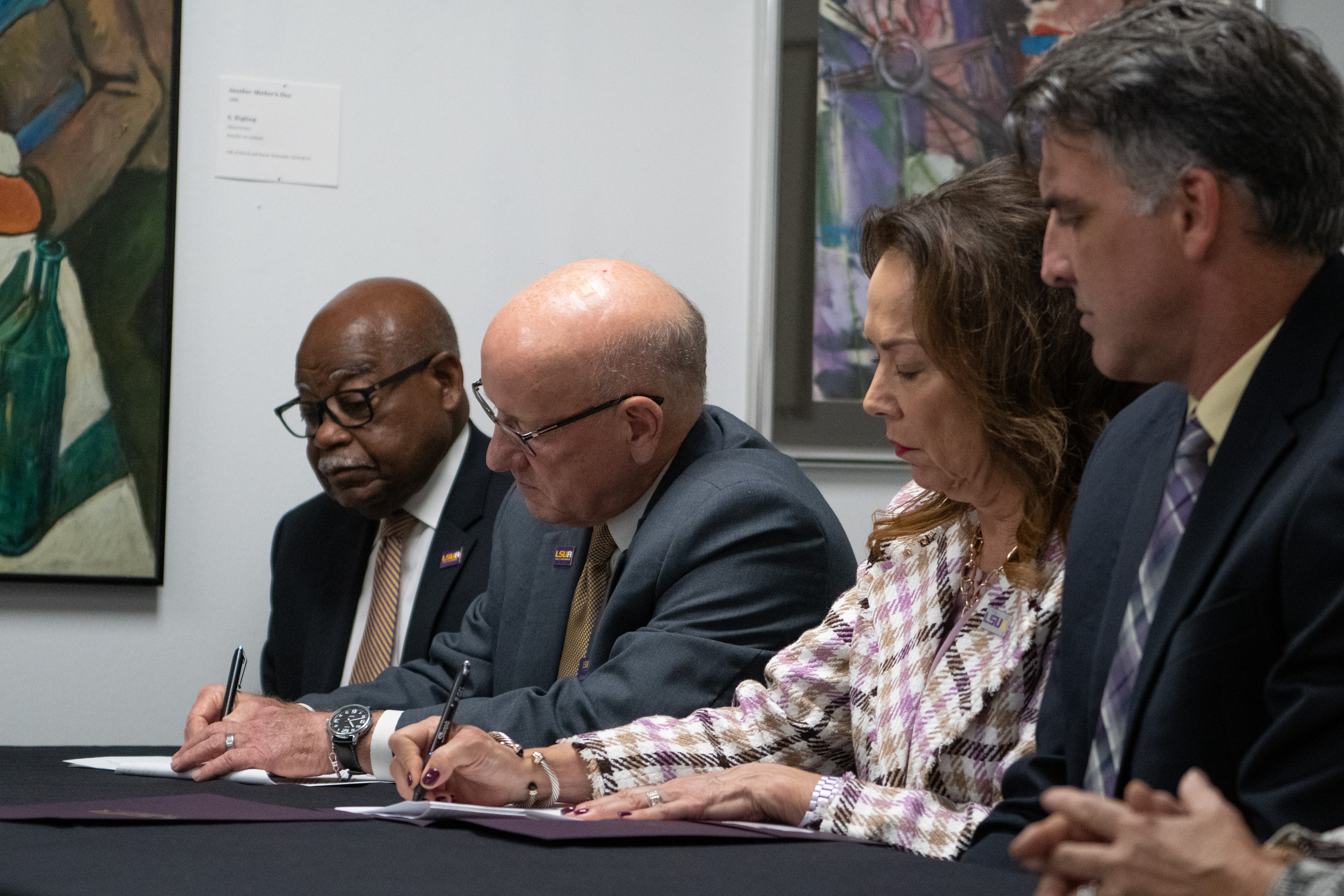Copyright Information
Introduction
Full compliance with intellectual property laws of the United States is the responsibility of each University employee and student. The Copyright Act of 1976 (P.L. 94-553) and its revisions and supplements must be observed. LSUE employees also must follow the policies set forth in PM 15: Copyright Guidelines Regarding Electronic Learning, and PM 17: Fair Use of Copyright Material.
Universities create and consume copyrighted materials of all kinds as a matter of course. Faculty and staff routinely author copyrightable works as part of their teaching, research, and community outreach roles. Conversely, these roles rely upon being able to use other people's copyrighted materials. Copyrighted works are both the fuel and the product of universities.
Digitization and the internet have made it much easier to locate, reproduce and redistribute copyrighted material. With the lowering of the barriers to copying and re-using other's works, combined with automatic copyright protection for original works, some knowledge of copyright law has become an inescapable necessity for university faculty, staff, and students.
Copyright Basics
What is a copyright? It is a limited monopoly given to authors and creators of intellectual property to control uses of their work.
Why was copyright created? The Constitutional purpose of copyright is to "promote the progress of science and the useful arts" by giving authors and creators limited monopoly over uses of their work. The enrichment of authors/creators is a secondary goal.
Fundamentals: Copyright protection
- Applies to works in every media format.
- Arises automatically (no action required) as soon as
- an original work (writing, photo, song, movie, etc.)
- is fixed in a tangible medium of expression (written, recorded, photographed, etc.)
- The © notice is no longer required for works created after 1989.
- Works do not need to be published or registered in order to be fully protected by copyright.
- However, timely registration with the U.S. Copyright Office will affect amount of damages recoverable.
Your default assumption should be that most works you encounter are copyrighted whether or not there is a copyright notice.
Fair Use
Perhaps the most critical limitation on the copyright holder's exclusive rights is the fair use exemption, codified in 17. U.S.C. §107. Fair use allows limited uses of portions (or sometimes all) of a copyrighted work without the need for prior permission. Favored fair uses include nonprofit educational, transformative uses or criticism, commentary or parody. Determining whether a particular use is fair requires weighing the four factors set forth in the statute:
- Purpose and character of the use;
- Nature of the copyrighted work;
- Amount and substantiality of the amount used;
- Effect or potential effect on the market or potential market for the work.
There are no clear-cut rules that state when a particular use might be a 'fair use.' Instead, the four fair use factors must be evaluated in the context of the specific facts of the proposed use. Because of this, a reasonable, good faith fair use analysis is necessarily fact-driven. Reasonable and knowledgeable people can, and often do, disagree about whether a particular use at a particular time is a fair one. The fair use provision, while uncomfortable for some who wish for more certainty, is a deliberate choice by Congress and the courts to allow the doctrine to have flexibility and achieve a responsible balance between needs of creators and those of society.
Fair use, therefore, provides the necessary play in the joints without which society would become gridlocked in trying obtain permissions for any use of any amount of a copyrighted work. Fair use will always be an educated opinion - the adage "when in doubt, get permission" is entirely incompatible with the good faith exercise of the intent and purpose of the fair use provision of copyright law. To assume that one "answer" exists for the infinite variety of situations would destroy the very flexibility fair use is intended to address.
Given that faculty and students are frequent users of third party copyrighted materials in their courses, the responsible exercise of fair use is particularly crucial to each and every course taught. What could be more mission critical?
As you read through this short overview of fair use it is easy to become overwhelmed, but keep in mind the following:
- Not all four factors need to favor fair use (usually at least half)
- Reasonable minds can differ over what is a fair use
- All that is expected of you, as an employee of a nonprofit educational institution doing your job, is that you take the time to do a reasonable/reasoned consideration of each factor in the context of your situation and make a good-faith, objective decision.
The Four Fair Use Factors
- The PURPOSE AND CHARACTER of the use, including whether the use is of a commercial nature or is for nonprofit educational purposes
- The purpose of the use: University nonprofit educational uses are favored fair uses. However, all factors must still be considered; educational use alone does not automatically constitute a fair use.
- The character of the use is more likely to weigh in favor of fair use if the proposed use is a transformative use as opposed to 'slavish' copying. Recent court decisions have emphasized that if a use is substantially transformative, the other fair use factors are less significant. Generally speaking, the test for a transformative use (a use of a copyrighted work that adds something new, with a further purpose or different character, altering the first with new expression, meaning, or message) is "does the use merely supersede the objects of the original creation or instead add something new, with a further purpose of different character, altering the first with new expression, meaning, or message." Blanch v. Koons, 467 F.3d 244 (2d Circ. 2006)
- The NATURE of the copyrighted work
- This factor generally weighs in favor of a finding of fair use if the work being used is primarily factual (scholarly, technical, scientific) as opposed to works that consist of lots of creative expression, such as plays, poems, fictional works, photographs, paintings and so forth.
- The AMOUNT AND SUBSTANTIALITY of the portion used in relation to the copyrighted work as a whole
- The amount factor is a sliding scale - the larger the portion of the work you wish to use, the less likely it will be considered to be a fair use. For example, using 50% or half of an entire work is less likely to be considered a fair use than using 10%. On the other hand, under the right set of facts, use of 100% of the work might be found to be fair as in the use of an entire image or graphic.
- Whether the proposed amount is a substantial amount looks at whether the proposed portion is the "heart of the matter." But just because a particular portion is selected for use does not necessarily mean that portion is the "heart.' That is, it has been argued in some copyright infringement lawsuits that the defendant would not have chosen the portion of the work to use if that portion wasn't the most important or best part of the entire work, i.e., the 'heart.' In that instance, the court rejected that reasoning pointing out that there are many reasons why a particular portion is chosen for inclusion, not necessarily because it is the 'heart.'
- The EFFECT of the use upon the potential market for or value of the copyrighted work
- If the proposed use became widespread and would negatively impact the market for or value of the copyrighted work, the fourth factor likely weighs against a finding of fair use. Note that there are two markets that are arguably relevant to this inquiry: the market for the work itself and the permissions market. Which is the relevant market? Should the permissions market be considered in the fourth factor analysis?
Why is a fair use analysis being done in the first place? It is being done to determine whether the proposed use is a fair one and, therefore, does not require permission and payment of permission fees. In other words, it is being done to decide whether permission and, therefore, permission fees are even due, keeping in mind that the copyright holder cannot lose what isn't hers to begin with.
Note that the permission fee market will always be affected if permission fees are not paid but you can't lose what isn't yours. Affecting a permissions market is not affecting the market for the work. In other words, just because a permissions market exists should not determine whether a fee is necessary in the first place.
Disclaimer
Materials on this website are provided for informational and educational use only and do not constitute legal advice.




